仁爱版英语七年级下Unit 6 Our local area语法复习课件(33张PPT无素材)
文档属性
| 名称 | 仁爱版英语七年级下Unit 6 Our local area语法复习课件(33张PPT无素材) |  | |
| 格式 | zip | ||
| 文件大小 | 12.8MB | ||
| 资源类型 | 教案 | ||
| 版本资源 | 仁爱科普版 | ||
| 科目 | 英语 | ||
| 更新时间 | 2020-06-12 01:00:52 | ||
图片预览

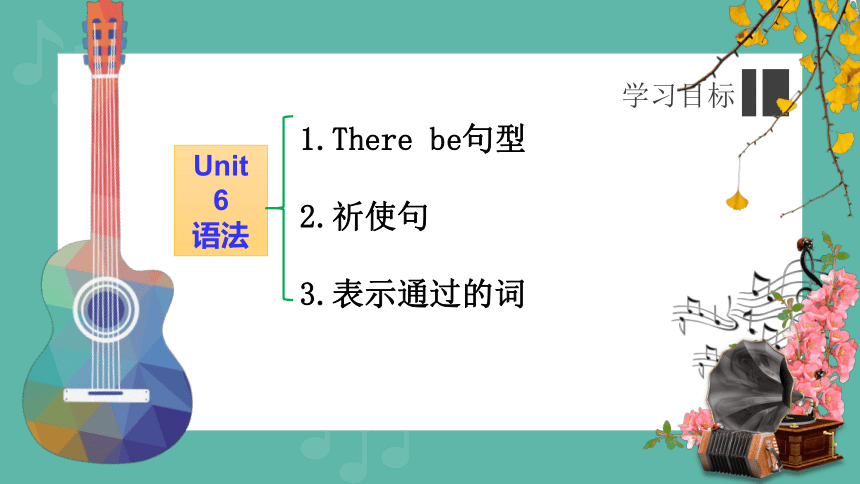
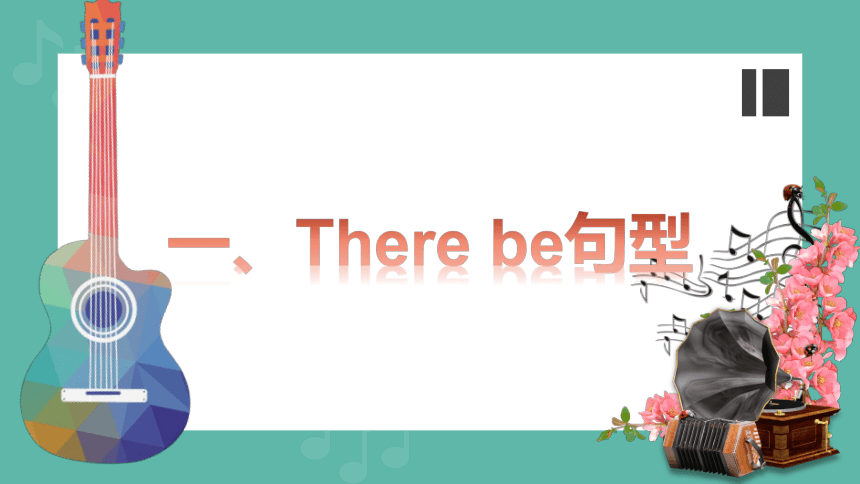
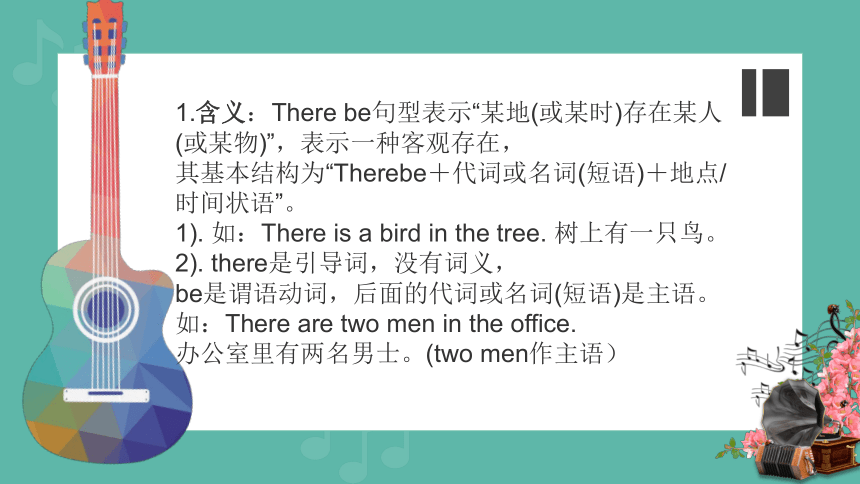

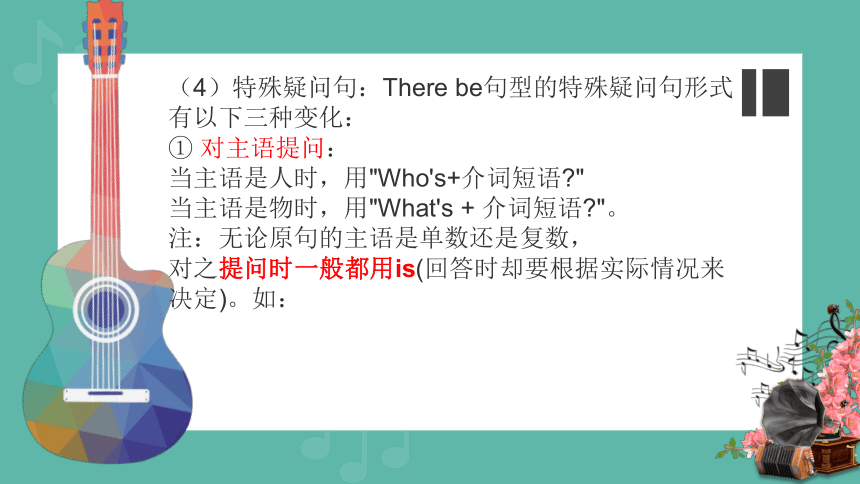
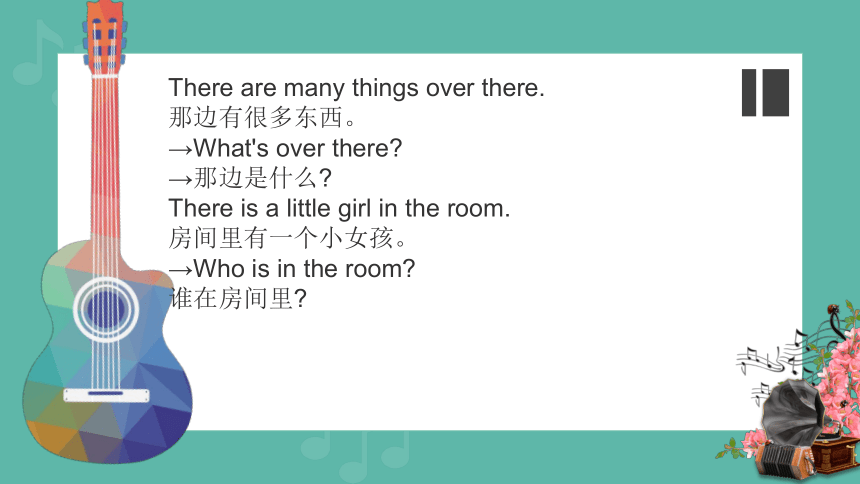



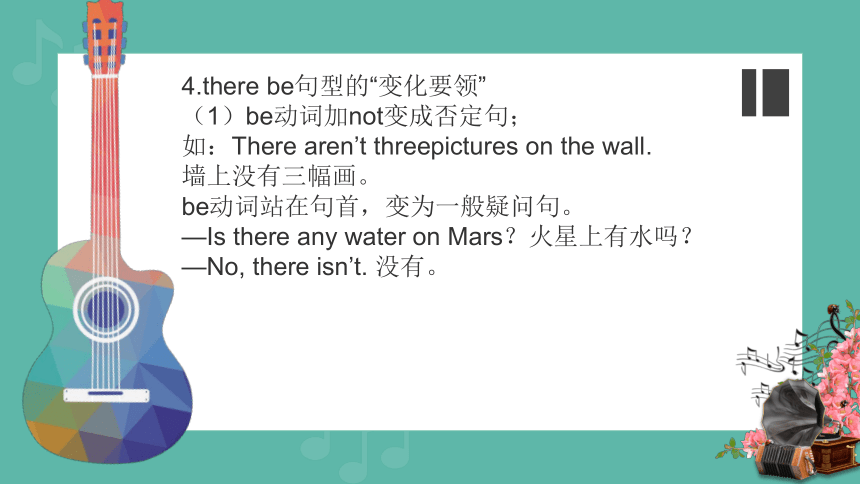
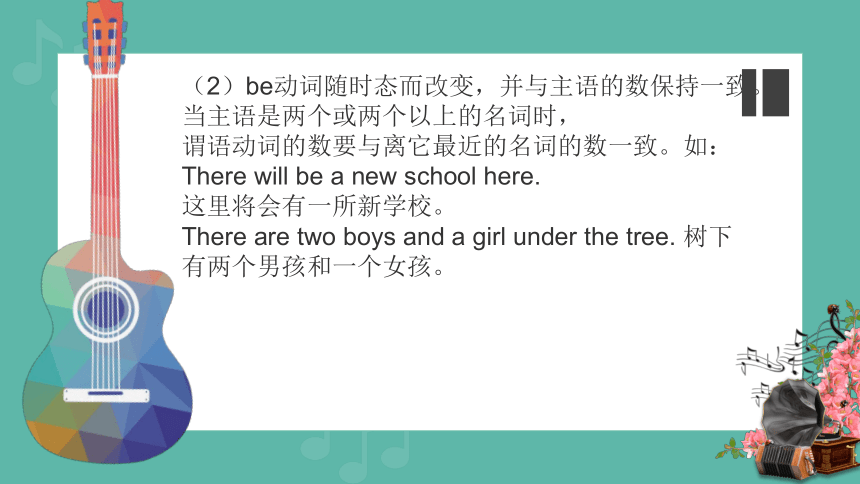
文档简介
(共33张PPT)
Unit
6
语法复习
学习目标
Unit
6
语法
1.There
be句型
2.祈使句
3.表示通过的词
一、There
be句型
1.含义:There
be句型表示“某地(或某时)存在某人(或某物)”,表示一种客观存在,
其基本结构为“Therebe+代词或名词(短语)+地点/时间状语”。
1).
如:There
is
a
bird
in
the
tree.
树上有一只鸟。
2).
there是引导词,没有词义,
be是谓语动词,后面的代词或名词(短语)是主语。
如:There
are
two
men
in
the
office.
办公室里有两名男士。(two
men作主语)
2.句型:
(1)肯定句:There
is
a
computer
in
your
study.
你的书房里有一台电脑。
(2)否定句--在“be”后加“not”:
There
isn’t
a
computer
in
your
study.
你的书房里没有电脑。
(3)一般疑问句--将“be”提到“there”之前:
Is
there
a
computer
in
your
study?
你的书房里有电脑吗?
----Yes,
there
is./
No,
there
isn’t.
是的,有。/不,没有。
(4)特殊疑问句:There
be句型的特殊疑问句形式有以下三种变化:
①
对主语提问:
当主语是人时,用"Who's+介词短语?"
当主语是物时,用"What's
+
介词短语?"。
注:无论原句的主语是单数还是复数,
对之提问时一般都用is(回答时却要根据实际情况来决定)。如:
There
are
many
things
over
there.
那边有很多东西。
→What's
over
there?
→那边是什么?
There
is
a
little
girl
in
the
room.
房间里有一个小女孩。
→Who
is
in
the
room?
谁在房间里?
②
对地点状语提问:提问地点用"Where
is
/
are+主语?"
“There
+
be+主语+地点状语”表示“某处有某物”;
例:There
is
a
computer
on
the
desk.
桌子上有一台电脑。
→
Where
is
the
computer?
计算机在哪里?
There
are
four
children
on
the
playground.
操场上有四个孩子。
→Where
are
the
four
children?
这四个孩子在哪里?
地点状语也可放在句首,有时可用“,”
与后面的部分隔开。
There
are
some
pictures
on
the
wall.
墙上有一些照片。
=On
the
wall,
there
are
some
pictures.
墙上有几幅画。
③
对数量提问:一般有两种句型结构:
How
many+复数名词+are
there+介词短语?
How
much+不可数名词+is
there+介词短语?
3.there
be?遵循就近原则。
There
be如果后面接两个名词作主语,
那么“be”的人称和数与邻近的名词一致。
即be
用is还是are,取决于离该动词最近的那个名词。
如果该名词是单数或不可数名词就用is,
如果是复数就用are。
★就近原则:
There
is
a
lamp
,
a
computer,
some
books
and
so
on.
有一盏灯,一台电脑,一些书等等。
There
are
two
boys
and
a
girl
under
the
tree.
树下有两个男孩和一个女孩。
4.there
be句型的“变化要领”
(1)be动词加not变成否定句;
如:There
aren’t
threepictures
on
the
wall.
墙上没有三幅画。
be动词站在句首,变为一般疑问句。
—Is
there
any
water
on
Mars?火星上有水吗?
—No,
there
isn’t.
没有。
(2)be动词随时态而改变,并与主语的数保持一致。当主语是两个或两个以上的名词时,
谓语动词的数要与离它最近的名词的数一致。如:
There
will
be
a
new
school
here.
这里将会有一所新学校。
There
are
two
boys
and
a
girl
under
the
tree.
树下有两个男孩和一个女孩。
(3)“There
be
+
sb.
doing
sth.+地点/时间状语”意为“有某人在某地(时)正做某事”。
如:
There
are
several
children
swimming
in
the
river.
河
里有几个孩子在游泳。
Look!
There
is
a
dog
running
after
a
cat
in
the
garden.
看!花园里有一条狗在追一只猫。
5.
There与be中间可插入一些表示推测的情态动词,以强调某种语气。
如:There
must
be
some
flowers
in
the
box.
盒子里肯定有些鲜花。
6、there
be句型与have的“较量”
1)there
be句型和have都表示“有”。
但there
be句型表状态,意为“某处存在某人或某物”,表示一种客观存在;
have表所属关系,意为“某人拥有某人或某物”。
表主观拥有,其主语是人。如:
There
are
many
kinds
of
trees.
有很多种树。
He
has
two
sons.
他有两个儿子。
There
is
a
dog
in
the
picture.
画中有一只狗。
The
dog
has
two
big
eyes.
狗有两只大眼睛。
2)当have表示“包括”、“存在”的含义时,There
be
句型与其可互换。
eg.?
?A
week
has
seven
days.
一个星期有七天。
=There
are
seven
days
in
a
week.
一周有七天。
7.“there
be”句型速记
(1)速记口诀
there
be句型有特点,主语放在
be
后面;
单数主语用?is,复数用
are记心间①;
多个主语并列时,就近原则是关键②。
变否定,很简单,be
后要把not
添;
疑问句也不难,把?be
提到there
前③。
肯定句中用?some,否定、疑问any换④。
(2)口诀解读
①There
be句型的基本结构为
“There
be+主语(某人或某物)+地点(副词或介词短语)”,
表示“某地存在某人(或某物)”,因此也叫“存在句”。当主语是不可数名词或单数名词时,be用is;
当主语是复数时,be用are。
There
is
a
ruler
on
the
desk.
书桌上有一把尺。
There
are
four
apples
on
the
tree.(长在树上)
树上有四个苹果。
②当主语是两个或两个以上的名词时,谓语动词的数要与离它最近的名词的数一致,即采用“临近原则”。
There
is
an
orange
and
some
bananas
in
the
basket.
=There
are
some
bananas
and
an
orange
in
the
basket.
篮
子里有一个橘子和一些香蕉。
③其否定句是在be后加not。一般疑问句是将be提到句首,句末变问号。肯定回答用:Yes,
there
is/are.;否定回答用No,
there
isn’t/aren’t.
e.g.There
are
some
pictures
on
the
wall.
墙上有一些照片。
→There
aren’t
any
pictures
on
the
wall.
墙上没有任何图画。
→Are
there
any
pictures
on
the
wall?
墙上有一些图画吗?
There
is
a
bike
behind
the
tree.
树后面有一辆自行车。
→There
isn’t
a
bike
behind
the
tree.
树后面没有一辆自行车。
→Is
there
a
bike
behind
the
tree?
树后面有一辆自行车吗?
④在肯定句中常用some,但在变为否定句或疑问句时,要把some改为any。
There
are
some
fish
in
the
water.
水里有一些鱼。
→Are
there
any
fish
in
the
water?
水里有鱼吗?
5.特别提醒
(1)“What’s
+表地点的介词短语”
用there
be句型来回答。
在问的时候,be用is,
而回答时,要视实际情况而选用is或are。
—What’s
on
the
desk?
桌子上有什么?
—There
are
5
eggs.
有5个鸡蛋。
(2)有时为了突出或强调地点状语,
也可把表地点的介词短语放在前面,后面加逗号。
Under
the
table
there
is
a
cat.在桌下有一只猫。
二、祈使句
祈使句
祈使句是用来表示请求、命令或建议的句子。
祈使句中的主语常常被省去。
句末用句号或感叹号,一般用降调读。
祈使句的谓语动词无时态和数的变化,统一用原形。
1.肯定的祈使句结构:
(1)
Do型。即“动词原形+宾语+其他”。
Open
the
door,
please!
请开门。
(2)
Be型。即“Be动词原形+
表语形容词
+其他”。
Be
quiet
for
a
moment.
你请安静一会儿。
(3)
Let型。即“Let+
宾语
+动词原形
+其他”。
Let
sb
do
sth.
Let’s
play
volleyball.让我们打排球吧。
2.否定的祈使句结构:
(1)Do型和Be型的否定式都是在句首加don’t构成。
1)Don’t+实义动词+原形;
Don’t
mention
it.别提它。
2)
Don’t
be+形容词+其他;
Don’t
be
late
again.
别再迟到了。
不要迟到:
Don’t
arrive
late.
=
Don’t
be
late.
?
上课/上学不要迟到:
Don’t
arrive
(be)
late
for
class/school.
(2)Let型的否定式有两种。
1)当let后的宾语为第三人称时,在句首加Don’t;
Don’t
let
sb
do
sth
Don’t
let
the
children
make
much
noise.
不要让孩子发出大的噪声。
2)当let后的宾语为第一人称时,
用“Let
+宾语+not+动词原形+其他”结构。
Let’s
not
worry
about
our
problems.
让我们不要担
心我们的问题。
(3)“No
+名词或动名词”,No+Ving.
常用于日常生活中的警示语。
No
entry.
禁止入内。
No
parking.
禁止停车。
3.主语省略(无主语):
Don’t
arrive
late
for
class.
主语不省略(有主语):
We
can’t
arrive
;ate
for
class.
三、表示通过的词
1.
across是介词,强调从一定范围的一边到另一边,且在物体表面或沿着某一条线的方向而进行的动作。
e.g.
My
house
is
across
the
river.
我家在河对岸。
You
can
go
across
the
bridge.
你可以越过这座桥。
2.
cross是动词,表示“穿过,越过,渡过”。
e.g.
Don’t
cross
the
road.
别穿过马路。
The
boy
is
crossing
the
street.
那男孩正穿过街道。
3.
across
from
在……对面
e.g.
The
school
is
across
from
the
post
office.
学校在邮局对面。
4.
past也是介词,指从某物旁边经过,意思是“走
过……,经过……”。
e.g.
He
often
walks
past
me
without
saying“Hello”.
他经常不打招呼从我身边走过。
Our
school
bus
drives
past
the
Great
Hall
of
the
People(人民大会堂).
我们乘坐的校车经过人民大会堂。
知识回顾
Unit
6语法
1.There
be句型
2.祈使句
3.表示通过的词
Thank
you!
Unit
6
语法复习
学习目标
Unit
6
语法
1.There
be句型
2.祈使句
3.表示通过的词
一、There
be句型
1.含义:There
be句型表示“某地(或某时)存在某人(或某物)”,表示一种客观存在,
其基本结构为“Therebe+代词或名词(短语)+地点/时间状语”。
1).
如:There
is
a
bird
in
the
tree.
树上有一只鸟。
2).
there是引导词,没有词义,
be是谓语动词,后面的代词或名词(短语)是主语。
如:There
are
two
men
in
the
office.
办公室里有两名男士。(two
men作主语)
2.句型:
(1)肯定句:There
is
a
computer
in
your
study.
你的书房里有一台电脑。
(2)否定句--在“be”后加“not”:
There
isn’t
a
computer
in
your
study.
你的书房里没有电脑。
(3)一般疑问句--将“be”提到“there”之前:
Is
there
a
computer
in
your
study?
你的书房里有电脑吗?
----Yes,
there
is./
No,
there
isn’t.
是的,有。/不,没有。
(4)特殊疑问句:There
be句型的特殊疑问句形式有以下三种变化:
①
对主语提问:
当主语是人时,用"Who's+介词短语?"
当主语是物时,用"What's
+
介词短语?"。
注:无论原句的主语是单数还是复数,
对之提问时一般都用is(回答时却要根据实际情况来决定)。如:
There
are
many
things
over
there.
那边有很多东西。
→What's
over
there?
→那边是什么?
There
is
a
little
girl
in
the
room.
房间里有一个小女孩。
→Who
is
in
the
room?
谁在房间里?
②
对地点状语提问:提问地点用"Where
is
/
are+主语?"
“There
+
be+主语+地点状语”表示“某处有某物”;
例:There
is
a
computer
on
the
desk.
桌子上有一台电脑。
→
Where
is
the
computer?
计算机在哪里?
There
are
four
children
on
the
playground.
操场上有四个孩子。
→Where
are
the
four
children?
这四个孩子在哪里?
地点状语也可放在句首,有时可用“,”
与后面的部分隔开。
There
are
some
pictures
on
the
wall.
墙上有一些照片。
=On
the
wall,
there
are
some
pictures.
墙上有几幅画。
③
对数量提问:一般有两种句型结构:
How
many+复数名词+are
there+介词短语?
How
much+不可数名词+is
there+介词短语?
3.there
be?遵循就近原则。
There
be如果后面接两个名词作主语,
那么“be”的人称和数与邻近的名词一致。
即be
用is还是are,取决于离该动词最近的那个名词。
如果该名词是单数或不可数名词就用is,
如果是复数就用are。
★就近原则:
There
is
a
lamp
,
a
computer,
some
books
and
so
on.
有一盏灯,一台电脑,一些书等等。
There
are
two
boys
and
a
girl
under
the
tree.
树下有两个男孩和一个女孩。
4.there
be句型的“变化要领”
(1)be动词加not变成否定句;
如:There
aren’t
threepictures
on
the
wall.
墙上没有三幅画。
be动词站在句首,变为一般疑问句。
—Is
there
any
water
on
Mars?火星上有水吗?
—No,
there
isn’t.
没有。
(2)be动词随时态而改变,并与主语的数保持一致。当主语是两个或两个以上的名词时,
谓语动词的数要与离它最近的名词的数一致。如:
There
will
be
a
new
school
here.
这里将会有一所新学校。
There
are
two
boys
and
a
girl
under
the
tree.
树下有两个男孩和一个女孩。
(3)“There
be
+
sb.
doing
sth.+地点/时间状语”意为“有某人在某地(时)正做某事”。
如:
There
are
several
children
swimming
in
the
river.
河
里有几个孩子在游泳。
Look!
There
is
a
dog
running
after
a
cat
in
the
garden.
看!花园里有一条狗在追一只猫。
5.
There与be中间可插入一些表示推测的情态动词,以强调某种语气。
如:There
must
be
some
flowers
in
the
box.
盒子里肯定有些鲜花。
6、there
be句型与have的“较量”
1)there
be句型和have都表示“有”。
但there
be句型表状态,意为“某处存在某人或某物”,表示一种客观存在;
have表所属关系,意为“某人拥有某人或某物”。
表主观拥有,其主语是人。如:
There
are
many
kinds
of
trees.
有很多种树。
He
has
two
sons.
他有两个儿子。
There
is
a
dog
in
the
picture.
画中有一只狗。
The
dog
has
two
big
eyes.
狗有两只大眼睛。
2)当have表示“包括”、“存在”的含义时,There
be
句型与其可互换。
eg.?
?A
week
has
seven
days.
一个星期有七天。
=There
are
seven
days
in
a
week.
一周有七天。
7.“there
be”句型速记
(1)速记口诀
there
be句型有特点,主语放在
be
后面;
单数主语用?is,复数用
are记心间①;
多个主语并列时,就近原则是关键②。
变否定,很简单,be
后要把not
添;
疑问句也不难,把?be
提到there
前③。
肯定句中用?some,否定、疑问any换④。
(2)口诀解读
①There
be句型的基本结构为
“There
be+主语(某人或某物)+地点(副词或介词短语)”,
表示“某地存在某人(或某物)”,因此也叫“存在句”。当主语是不可数名词或单数名词时,be用is;
当主语是复数时,be用are。
There
is
a
ruler
on
the
desk.
书桌上有一把尺。
There
are
four
apples
on
the
tree.(长在树上)
树上有四个苹果。
②当主语是两个或两个以上的名词时,谓语动词的数要与离它最近的名词的数一致,即采用“临近原则”。
There
is
an
orange
and
some
bananas
in
the
basket.
=There
are
some
bananas
and
an
orange
in
the
basket.
篮
子里有一个橘子和一些香蕉。
③其否定句是在be后加not。一般疑问句是将be提到句首,句末变问号。肯定回答用:Yes,
there
is/are.;否定回答用No,
there
isn’t/aren’t.
e.g.There
are
some
pictures
on
the
wall.
墙上有一些照片。
→There
aren’t
any
pictures
on
the
wall.
墙上没有任何图画。
→Are
there
any
pictures
on
the
wall?
墙上有一些图画吗?
There
is
a
bike
behind
the
tree.
树后面有一辆自行车。
→There
isn’t
a
bike
behind
the
tree.
树后面没有一辆自行车。
→Is
there
a
bike
behind
the
tree?
树后面有一辆自行车吗?
④在肯定句中常用some,但在变为否定句或疑问句时,要把some改为any。
There
are
some
fish
in
the
water.
水里有一些鱼。
→Are
there
any
fish
in
the
water?
水里有鱼吗?
5.特别提醒
(1)“What’s
+表地点的介词短语”
用there
be句型来回答。
在问的时候,be用is,
而回答时,要视实际情况而选用is或are。
—What’s
on
the
desk?
桌子上有什么?
—There
are
5
eggs.
有5个鸡蛋。
(2)有时为了突出或强调地点状语,
也可把表地点的介词短语放在前面,后面加逗号。
Under
the
table
there
is
a
cat.在桌下有一只猫。
二、祈使句
祈使句
祈使句是用来表示请求、命令或建议的句子。
祈使句中的主语常常被省去。
句末用句号或感叹号,一般用降调读。
祈使句的谓语动词无时态和数的变化,统一用原形。
1.肯定的祈使句结构:
(1)
Do型。即“动词原形+宾语+其他”。
Open
the
door,
please!
请开门。
(2)
Be型。即“Be动词原形+
表语形容词
+其他”。
Be
quiet
for
a
moment.
你请安静一会儿。
(3)
Let型。即“Let+
宾语
+动词原形
+其他”。
Let
sb
do
sth.
Let’s
play
volleyball.让我们打排球吧。
2.否定的祈使句结构:
(1)Do型和Be型的否定式都是在句首加don’t构成。
1)Don’t+实义动词+原形;
Don’t
mention
it.别提它。
2)
Don’t
be+形容词+其他;
Don’t
be
late
again.
别再迟到了。
不要迟到:
Don’t
arrive
late.
=
Don’t
be
late.
?
上课/上学不要迟到:
Don’t
arrive
(be)
late
for
class/school.
(2)Let型的否定式有两种。
1)当let后的宾语为第三人称时,在句首加Don’t;
Don’t
let
sb
do
sth
Don’t
let
the
children
make
much
noise.
不要让孩子发出大的噪声。
2)当let后的宾语为第一人称时,
用“Let
+宾语+not+动词原形+其他”结构。
Let’s
not
worry
about
our
problems.
让我们不要担
心我们的问题。
(3)“No
+名词或动名词”,No+Ving.
常用于日常生活中的警示语。
No
entry.
禁止入内。
No
parking.
禁止停车。
3.主语省略(无主语):
Don’t
arrive
late
for
class.
主语不省略(有主语):
We
can’t
arrive
;ate
for
class.
三、表示通过的词
1.
across是介词,强调从一定范围的一边到另一边,且在物体表面或沿着某一条线的方向而进行的动作。
e.g.
My
house
is
across
the
river.
我家在河对岸。
You
can
go
across
the
bridge.
你可以越过这座桥。
2.
cross是动词,表示“穿过,越过,渡过”。
e.g.
Don’t
cross
the
road.
别穿过马路。
The
boy
is
crossing
the
street.
那男孩正穿过街道。
3.
across
from
在……对面
e.g.
The
school
is
across
from
the
post
office.
学校在邮局对面。
4.
past也是介词,指从某物旁边经过,意思是“走
过……,经过……”。
e.g.
He
often
walks
past
me
without
saying“Hello”.
他经常不打招呼从我身边走过。
Our
school
bus
drives
past
the
Great
Hall
of
the
People(人民大会堂).
我们乘坐的校车经过人民大会堂。
知识回顾
Unit
6语法
1.There
be句型
2.祈使句
3.表示通过的词
Thank
you!
同课章节目录
- Unit 5 Our school life
- Topic 1 I usually come to school by subway.
- Topic 2 A few students are running around the play
- Topic 3 My school life is very interesting.
- Unit 6 Our local area
- Topic 1 Is there a computer in your study?
- Topic 2 My home is in an apartment building.
- Topic 3 Which is the way to the hospital?
- Review of Units 5-6
- Unit 7 The Birthday
- Topic 1 When is your birthday?
- Topic 2 Can you sing an English song?
- Topic 3 Everyone had a good time.
- Unit 8 The seasons and the Weathe
- Topic 1 What's the weather like in summer?
- Topic 2 The summer holidays are coming.
- Topic 3 Let’s celebrate!
- Review of Units 7-8
- 旧版资料
- Unit 5 Our School Life
- Unit 6 Our Local Area
- Unit 7 The Birthday
- Unit 8 The seasons and the Weathe
- Unit 7 Celebrating the Birthday(老版本)
